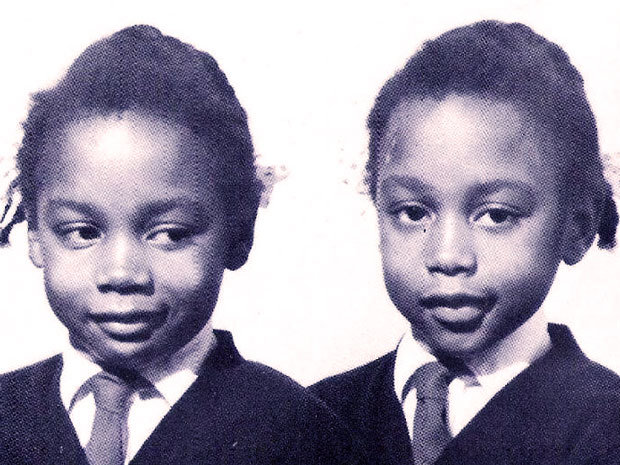
June and Jennifer Gibbons
"Zombies." That's the best descriptor medical experts who met identical siblings June and Jennifer Gibbons could come up with to describe the young women. They didn't speak. They walked in a synchronized fashion. They were the Silent Twins. And they unsettled everyone who came into contact with them.
Everyone, that is, except for
Sunday Times investigative journalist Marjorie Wallace. Wallace befriended the twins in the 1980s and wrote about their shared life and its mysterious end in the 1986 biography
The Silent Twins (that's a version of the cover above).
Born in 1963, June and Jennifer were moved by their Barbadian parents to a small town off the coast of Wales called Haverfordwest. Known for its tranquility, the town and the twins had but one thing in common: Quiet.
Amazingly, the two had never spoken to anyone else their entire lives. Instead, they communicated with each other in a strange, birdlike language only they could understand.
Haverfordwest was a predominantly white town, and the siblings were consistently bullied at school because of their race. Their continued resistance to speak to outsiders only resulted in more exclusion. Eventually, June and Jennifer withdrew from society entirely and turned to literature as an outlet for their pent up aggressions.
At age 14, the twins were separated in an attempt to encourage socialization. They responded by slipping into catatonic states. Doctors and family members reunited the siblings thereafter, and they spent the next few years holed up their room, performing intricate plays for one another and writing extensively in their diaries.
It was on the blank page that June and Jennifer revealed the darkness of their bond, exploring the joint need and hatred they felt toward one another. June wrote, "Nobody suffers the way I do, not with a sister; with a husband, yes; with a wife, yes; with a child, yes, but this sister of mine, a dark shadow robbing me of sunlight, is my one and only torment."
Born 10 minutes apart, Jennifer viewed her older sibling as mightier in every way—looks, brains, wits. For her part, June sensed the envy, writing, "She wants us to be equal. There is a murderous gleam in her eye. Dear lord, I am scared of her. She is not normal ... someone is driving her insane. It is me."
A chilling excerpt from Jennifer's diary further illustrates their shared disdain, and possibly sheds light on why the two took to inflicting bodily harm on one another: "We have become fatal enemies in each other's eyes. We feel the irritating deadly rays come out of our bodies, stinging each other's skin. I say to myself, can I get rid of my own shadow, impossible or not possible? Without my shadow, would I die? Without my shadow, would I gain life, be free or left to die? Without my shadow, which I identify with a face of misery, deception, murder."
Such writing was a major creative outlet for the Gibbons twins. They even penned a few novels, though the books continued themes of mayhem and violence. June's
Pepsi-Cola Addict is about a teen who's seduced by his schoolteacher then sent away to a reformatory where he fights off the advances of a homosexual guard. Jennifer's
Discomania is a disturbing little tale about the "insane violence" that goes down at a disco.
The books failed to make a serious splash in the literary world. So the Gibbons twins found another way to get noticed: criminal mischief. They got their thrills from petty theft, choking each other, and, eventually, burning buildings to the ground. It's the latter offense that landed them in court. A judge ruled their deviant behavior combined with their severe social disorders were grounds for confinement. He sent them to Broadmoor Hospital, the very same high-security mental facility where legendary British gangster Ronnie Kray lived out the remainder of his life.
At Broadmoor, the doctors found June and Jennifer to be deeply disturbed, even dangerous. The two took turns eating, one indulging one day while the other starved. And though they were split up and housed in cells on opposite ends of the hospital, nurses often found them eerily frozen in the same distinct poses. This went on for 11 years. Until doctors agreed to transfer the twins to Caswell Clinic, a lower-security facility in Bridgend, Wales.
Only one of the sisters would survive the relocation. Wallace claimed that during her final visit with the twins at Broadmoor, Jennifer abruptly stated over a cup of tea, "Marjorie, Marjorie, I'm going to have to die." When Wallace asked why, Jennifer just said, "Because we decided."
Indeed, as Wallace states in
The Silent Twins, the Gibbons siblings made a pact at Broadmoor: One of them had to die, so the other could live a normal life.
In March of 1993, June and Jennifer Gibbons, ages 31, were transferred to Caswell. Upon arrival, Jennifer appeared unresponsive. Doctors rushed her to the hospital where she was pronounced dead. Cause of death? Acute myocarditis, or a sudden and lethal inflammation of the heart.
Doctors found no evidence of poison in Jennifer's system. According to June, Jennifer simply placed her head on her twin sibling's shoulder. She then took her last breath, and said, "
AT LONG LAST, WE'RE OUT."
After Jennifer's death in 1993, June went on to live a so-called "normal" life. She sat down for a revealing
INTERVIEW with
The New Yorker's Hilton Als, stating all she wanted now was to get married to and have children with a "Rasta" man, like Bob Marley.
As for her sister, Jennifer? She's buried under a headstone engraved with a poem written by June. It reads: "We once were two/We two made one/We no more two/Through life be one/Rest in peace."
Read more about June and Jennifer Gibbons in
The Silent Twins by Marjorie Wallace.
Comment: Read more about the Gibbons twins here.